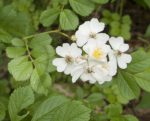 Multiflora rose is a multi-stemmed shrub or climbing vine that is probably the parent of ramblers and the popular Polyantha roses of today. It grows five to twelve feet tall and has bright green to reddish arching stems that usually bear recurved prickles. The leaves are pinnately compound and have five to eleven elliptical, sharply toothed leaflets up to one inch long, and feathered stipules. The fragrant white to pink flowers are one inch across and produced in large clusters in early summer. They give way to clusters of reddish to purple edible hips in the in late summer that persist into winter. Native to Japan, Korea, and eastern China, multiflora rose was introduced into eastern US in 1866 as a rootstock for ornamental roses but was subsequently used for erosion control, as a living fence for livestock, as food and cover for wildlife, and on highway medians to reduce headlight glare and act as a crash barrier. It escaped cultivation and is now considered invasive from New Brunswick and Ontario, south to Florida and Texas, and in the Pacific Northwest where it has spread into fields, forests, stream banks, some wetlands and other habitats, often forming thickets that crowd out native vegetation. It is a host for the deadly rose rosette disease that is carried by wind borne mites and is a serious threat to roses of all kinds.
Multiflora rose is a multi-stemmed shrub or climbing vine that is probably the parent of ramblers and the popular Polyantha roses of today. It grows five to twelve feet tall and has bright green to reddish arching stems that usually bear recurved prickles. The leaves are pinnately compound and have five to eleven elliptical, sharply toothed leaflets up to one inch long, and feathered stipules. The fragrant white to pink flowers are one inch across and produced in large clusters in early summer. They give way to clusters of reddish to purple edible hips in the in late summer that persist into winter. Native to Japan, Korea, and eastern China, multiflora rose was introduced into eastern US in 1866 as a rootstock for ornamental roses but was subsequently used for erosion control, as a living fence for livestock, as food and cover for wildlife, and on highway medians to reduce headlight glare and act as a crash barrier. It escaped cultivation and is now considered invasive from New Brunswick and Ontario, south to Florida and Texas, and in the Pacific Northwest where it has spread into fields, forests, stream banks, some wetlands and other habitats, often forming thickets that crowd out native vegetation. It is a host for the deadly rose rosette disease that is carried by wind borne mites and is a serious threat to roses of all kinds.
Flower Size: 1” diameter
Petal Count: 5
Scent: Fragrant
Flowering: Early summer
Plant Size: 5-12’ H x 6-8 W
Hardiness: Zones 5-8